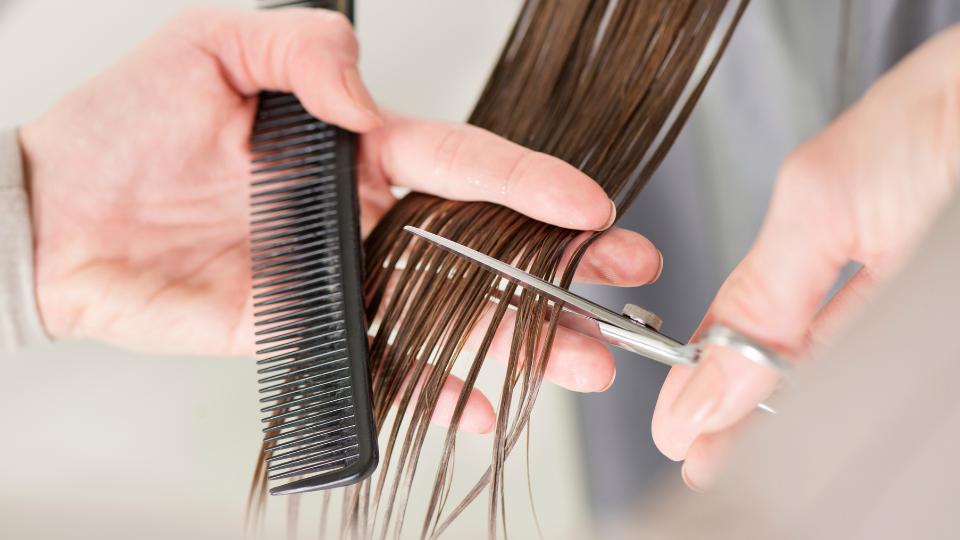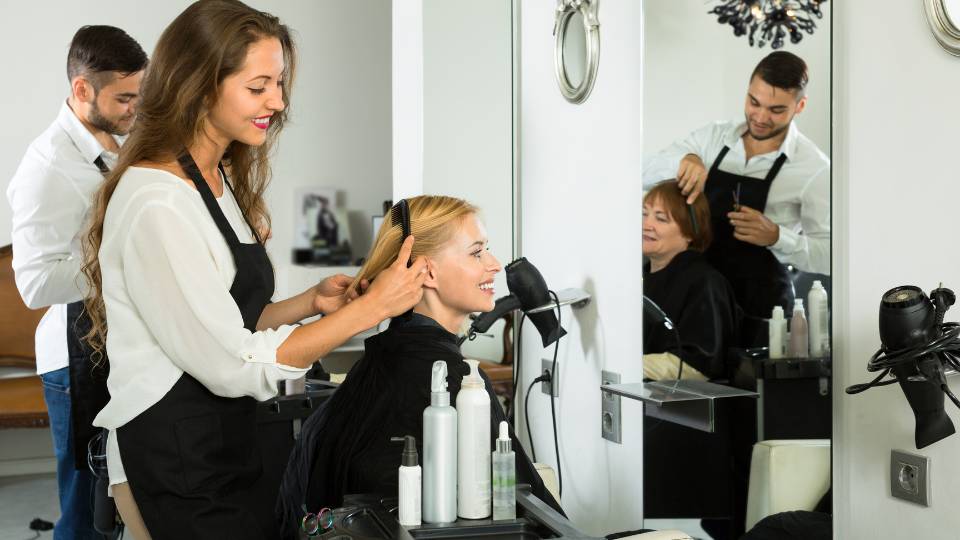
In the busy salon industry in the UK, beautification is a priority, but so is responsible salon waste management.
As a salon owner in the UK, understanding and effectively managing salon waste is crucial.
This comprehensive guide to salon waste will walk you through everything you might need to know about best practices for salon waste disposal.
Looking for something different? read our dedicated page on aesthetics and beauticians here.
Table of Contents:
- What is Salon Waste?
- Salon Waste Laws and Regulations in the UK
- How to Reduce Salon Waste
- UK Salon Waste Statistics and Facts
- Conclusion
What is Salon Waste?
Salon waste includes any waste that is generated by the business operations of a salon.
This can include a variety of materials generated during daily operations, including hair clippings, used chemicals, empty product containers, and more.
Properly managing these waste streams is not only a legal requirement but also contributes to environmental sustainability.
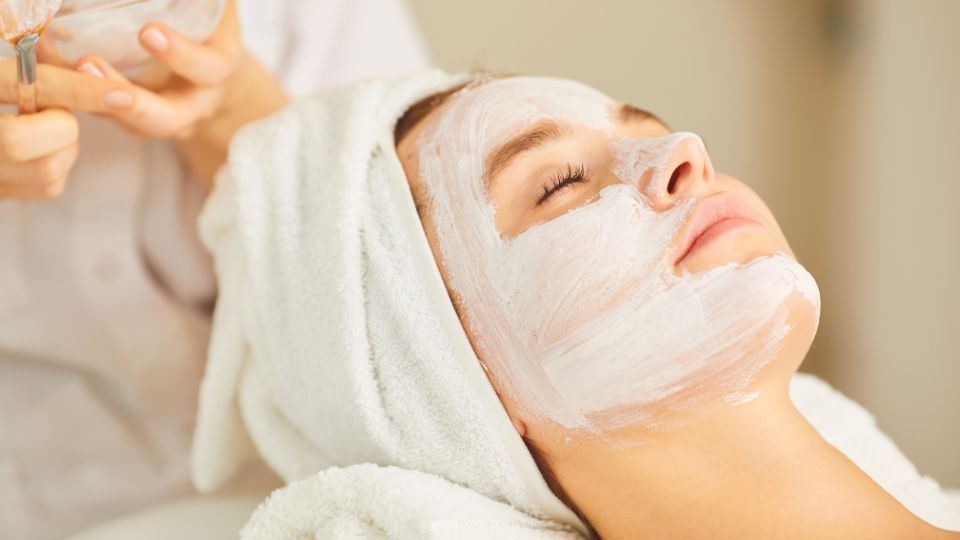
Salon Waste Laws and Regulations in the UK
Understanding and complying with UK salon waste laws is imperative for any salon owner.
The Environmental Protection Act 1990, the Environmental Act 2021, the Duty of Care regulations and the Controlled Waste Regulations Act 2012 lay the foundation for UK salon waste management.
It is essential to familiarise yourself with these regulations to avoid potential legal consequences.
Key Regulations to Note
1. Waste Classification: Understanding Controlled Waste in Salons
Salon waste, being a distinctive category known as controlled waste, is subject to specific regulations in the UK.
Controlled waste includes any waste material that arises from commercial, industrial, or business activities.
In the context of salons, this includes hair clippings, used chemical products, disposable towels, and other materials generated during daily operations.
It is paramount for salon owners to correctly classify their waste as controlled waste.
Failure to do so can result in legal consequences and pose environmental risks.
The proper identification of salon waste allows for appropriate disposal methods and ensures compliance with waste management regulations.
2. Duty of Care: Safeguarding the Environment and Public Health
Adhering to the Duty of Care regulations is not just a legal obligation; it’s a commitment to safeguarding the environment and public health.
As a salon owner, you have a duty to ensure that salon waste is handled responsibly from the point of generation to its ultimate disposal.
This duty extends to anyone involved in the management of the waste, including salon staff, waste carriers, and disposal facilities.
Practising Duty of Care involves:
- Proper Storage:
Implementing secure storage practices to prevent spillage or leakage of hazardous substances.
This includes using leak-proof containers for chemicals and ensuring waste storage areas are well-maintained.
- Safe Transportation:
Choosing licensed waste carriers (just like us!) to transport salon waste, guaranteeing that they adhere to regulations and have the necessary permits for waste transportation.
- Responsible Disposal:
Selecting disposal methods that align with environmental standards and regulations.
This may involve using licensed disposal facilities equipped to handle specific types of salon waste.
By upholding Duty of Care, salon owners contribute to a cleaner and healthier environment while preventing potential harm to the public.
3. Waste Transfer Notes (WTNs): Establishing a Trail of Responsibility
Documenting the transfer of salon waste through Waste Transfer Notes (WTNs) is a fundamental aspect of waste management regulations in the UK.
WTNs serve as a legal requirement to track and record the movement of waste from the salon to the waste disposal facility.
Key elements of WTNs include:
- Details of Waste:
Specific information about the type and quantity of waste being transferred.
- Transfer Points:
Noting where the waste is transferred, whether it’s from the salon to a waste collection vehicle or from the vehicle to a disposal facility.
- Parties Involved:
Identifying all parties involved in the waste transfer process, including the salon, waste carriers, and disposal facilities.
- Date and Time:
Recording the date and time of waste transfer for accurate tracking.
By diligently completing WTNs, salon owners establish a clear trail of responsibility.
This documentation is not only a legal necessity but also a tool for accountability, ensuring that every step of the waste management process is transparent and compliant with regulations.
4. The Right Bins for the Right Waste
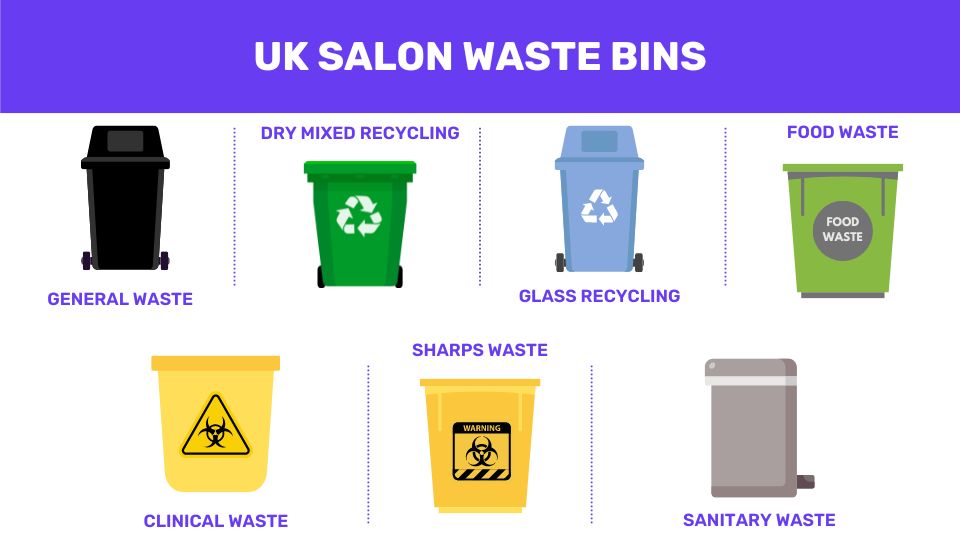
Your salon will need different bins depending on what type of waste you’re producing.
- General Waste Bin
Non-recyclable packaging, tissues
- Dry Mixed Recycling Bin
Paper, cardboard, plastic bottles, aluminium cans
- Glass Recycling Bin
Glass bottles, glass containers
- Food Waste Bin
Leftover food, coffee grounds, vegetable peels
- Clinical Waste Bin
Used bandages, disposable gloves, contaminated materials
- Sharps Waste Bin
Used needles, razor blades, sharp objects
- Sanitary Waste Bin
Used feminine hygiene products, nappies
How to Reduce Salon Waste
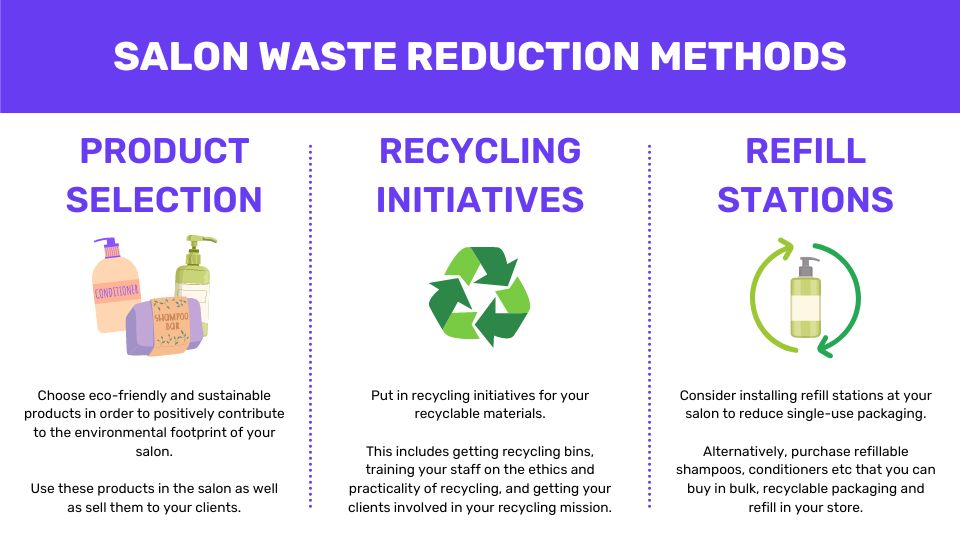
1. Product Selection
Choosing eco-friendly and sustainable products is a significant step towards reducing the environmental footprint of your salon.
Consider the following strategies when selecting products for your business:
Eco-Friendly Haircare Products
Explore haircare brands that prioritise sustainability, offering products with biodegradable ingredients, minimal packaging, and environmentally conscious sourcing.
This not only benefits the environment but also appeals to eco-conscious clients.
Examples could include shampoo bars which come with no packaging whatsoever and are biodegradable!
Sustainable Packaging Solutions
Opt for products that come in recyclable or compostable packaging.
Look for brands committed to reducing plastic waste by using alternative materials or offering refillable packaging options.
Cruelty-Free and Vegan Options
Consider incorporating cruelty-free and vegan products into your salon’s offerings.
This aligns with ethical and sustainable practices, appealing to a growing market of consumers who prioritise cruelty-free beauty options.
2. Recycling Initiatives
Implementing recycling initiatives in your salon is a proactive approach to waste reduction.
Educate your staff on the importance of proper sorting and recycling practices:
Designated Recycling Bins:
Place clearly labelled recycling bins in easily accessible areas throughout the salon.
Categorise bins for specific materials like paper, cardboard, plastics, and glass.
This makes it convenient for both staff and clients to participate in the recycling process.
Staff Training
Conduct training sessions to educate your team about the significance of recycling and the proper disposal of salon waste.
Emphasise the importance of sorting materials correctly to avoid contamination and maximise the effectiveness of recycling efforts.
Client Involvement
Encourage clients to participate in your recycling initiatives by placing informative signage near bins and on mirrors.
Consider offering incentives or discounts to clients who bring their own reusable bags or containers.
3. Refill Stations
Installing refill stations in your salon promotes a circular economy and minimises single-use packaging. Consider the following steps to successfully implement refill stations
Product Selection for Refill
Choose popular salon products that are available in bulk or concentrate form.
Work with suppliers who support refill initiatives, offering larger containers that can be used to replenish smaller, reusable containers.
Informative Signage
Place clear and engaging signage near refill stations to guide both staff and clients on the proper usage.
Include information about the environmental benefits of using refillable products and how it contributes to waste reduction.
Cost-Effective Solutions
Explore the cost-effectiveness of refill stations for both your business and clients.
Often, bulk purchasing can result in cost savings, which can be passed on to clients who choose the refill option.
This not only benefits the environment but also creates a positive incentive for sustainable choices.
By incorporating these practices into your salon’s daily operations, you not only contribute to environmental sustainability but also position your business as a leader in responsible and eco-conscious beauty practices.
4. Hair Recycling Programmes
Hair recycling programmes offer an innovative approach to repurposing salon-generated hair clippings for environmental benefit.
Instead of discarding hair as waste, salons can engage in these programs, contributing to sustainability and conservation efforts.
The recycled hair finds application in various areas such as oil spill cleanup, gardening and composting, wildlife habitat creation, and textile manufacturing.
- Oil Spill Clean Ups:
Salons can participate by providing hair clippings for the creation of mats and booms used in oil spill cleanup.
- Gardening & Composting
The clippings, rich in nitrogen, can also serve as a natural fertiliser for local gardeners and farmers, promoting healthier soil and diverting waste from landfills.
- Wildlife Conservation
Participating in wildlife habitat creation involves collecting clippings for bird nesting material.
Some programs explore the use of hair fibres in textile manufacturing as a sustainable alternative, though this is still in the experimental stage.
To join a hair recycling program, salons should research local initiatives or partner with waste management companies specialising in sustainable solutions.
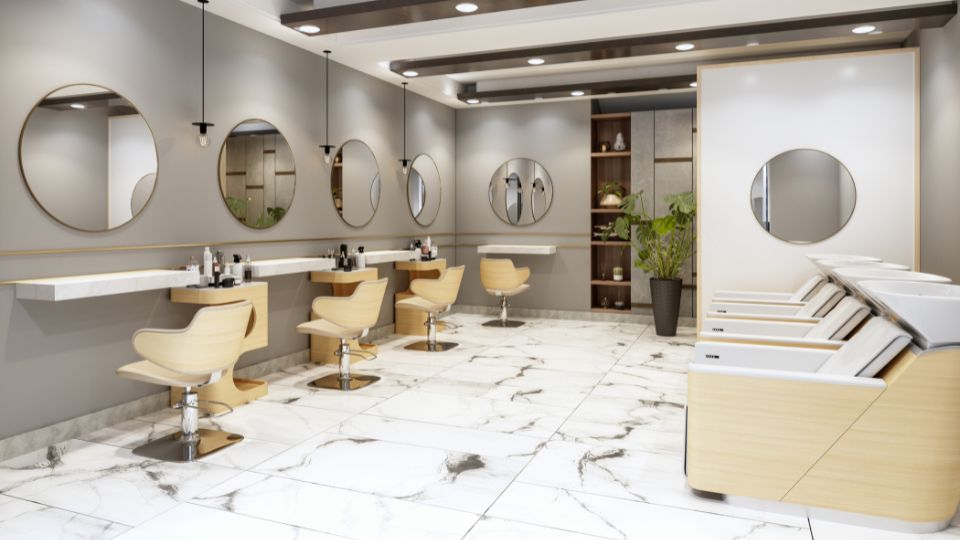
UK Salon Waste Statistics and Facts
- Did you know that hair salons create enough waste to fill up 50 football stadiums every single year? And the majority of the waste sadly goes straight to landfill.
- Around 99% of hair cuttings end up in landfill every year, even though it can be reused for other products!
- Beauty salons dispose of more than 1.3 million tools every single month! All of them going to landfill.
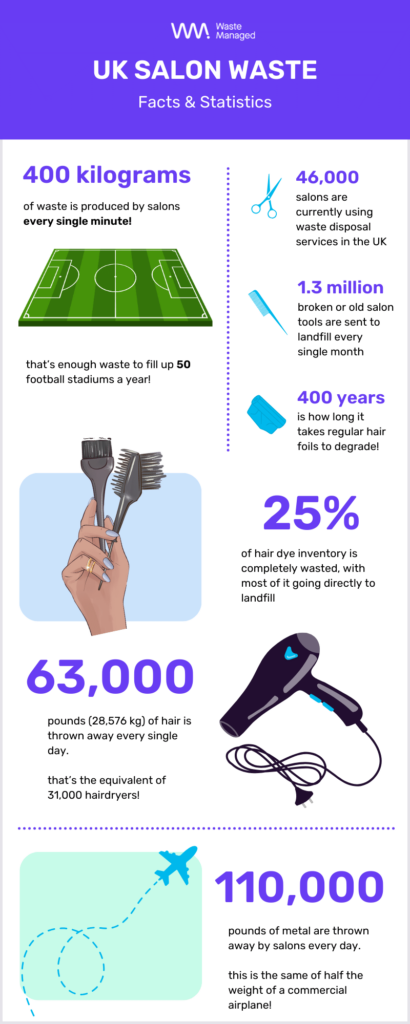
Don’t forget to share these stats on your socials!
Spread awareness about responsible waste disposal today.
Conclusion
Effectively managing salon waste is not just a legal obligation; it’s a commitment to environmental stewardship.
By embracing sustainable practices, staying informed about regulations, and utilising innovative technologies, UK salon owners can contribute to a greener future.
Feel free to share this guide with fellow salon owners, helping create a community dedicated to responsible salon waste management.
Together, we can make a significant impact on the environment while maintaining the beauty and success of our businesses.



